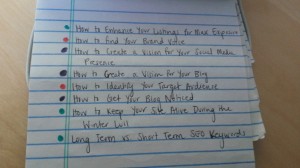Creating the Content Web: Letting Go of the Linear
I joined the Union Street Media team this past spring – doe-eyed and eager to get the ball rolling. One of the very first projects I tackled was building a content web and blogging schedule for our team.
Don’t worry. I survived the experience, and I didn’t lose any hair in the process. It was actually fun (really). And now I’ll show you how I did it.
First, let’s talk about the concept of a content web.
Letting Go of the Linear
You might think that you should just write content whenever it comes to you. You know, in a blogging-by-the-seat-of-your-pants kind of way. You would be wrong.
There are two kinds of real estate bloggers.
Type 1: This real estate agent blogs every week. They usually publish their posts on Wednesdays. Every Wednesday morning, they sit down at their computer and think about what to write. Once they have an idea, they quickly draft some sentences and publish the post. Next week: wash, rinse, repeat.
This blogger doesn’t see much engagement on their posts. Visitors tend to only read one post before leaving the site.
Type 2: This agent also blogs every week, and their publish day also lands on Wednesdays. They already have a strategic blogging schedule set up. They write about subjects in clusters – three or four weeks of blog posts per subject. Each post references posts in the past and posts to come.
This real estate blogger is a known authority online. They see continual engagement on their posts, and visitors read through multiple posts before leaving. This blog is often bookmarked and shared via social media.
So which blogger do you want to be? Type 2? Good, let’s continue.
Brain Dump
First thing’s first: pour out all of your blog ideas onto a page. Anything goes at this stage in the brainstorming process. The important thing is to exhaust all possible ideas.
Pro tip: Sometimes when I get stuck and can’t think of ideas, I jot down a stream of consciousness and draw inspiration from those ideas. It sounds silly, but it actually. Here’s an example (keep in mind that my audience is made up of real estate agents and real estate professionals):
Okay… admittedly not my best. But you get the idea. If you’re stuck, don’t stop the ideas from flowing. I probably wouldn’t write about Kim Kardashian in our real estate blog, but I opened up my thought process and can keep going until I find a good idea.
Organize and Synthesize
Once you have all of your ideas written down, go through and cut out the fat. Remove boring topics; if you don’t want to write about something, then your visitors won’t want to read it.
Next, group blog posts based on common subjects. I like to use color coding.
Once your blog posts are group, you’ll have a better sense of the overarching topics that you’ll cover over the next few months. You’ll also know which of your subjects are oddball topics that aren’t related to your other ideas.
Schedule
Begin scheduling your posts – you can use a Google calendar, an Excel spreadsheet, or a good ol’ fashioned paper calendar. Figure out how often you want to publish on the blog, and start setting the blog posts in your calendar. Remember to keep related blog posts together. If you have five posts that are related to social media, you should schedule them around the same time to build momentum for your writing.
Pro tip: Remember to set periodic reminders for yourself to publish on a regular schedule.
Start Writing
Once everything is scheduled, all you have to worry about is when to start writing! As you write your posts, think about how each one relates to the others in your queue. If you reference something you wrote about in the past, link to it. If you’re writing a post that you know you’ll talk about again in a few weeks, mention that to your readers.
Got any tips for building a blogging schedule? Let us know in the comments below.






